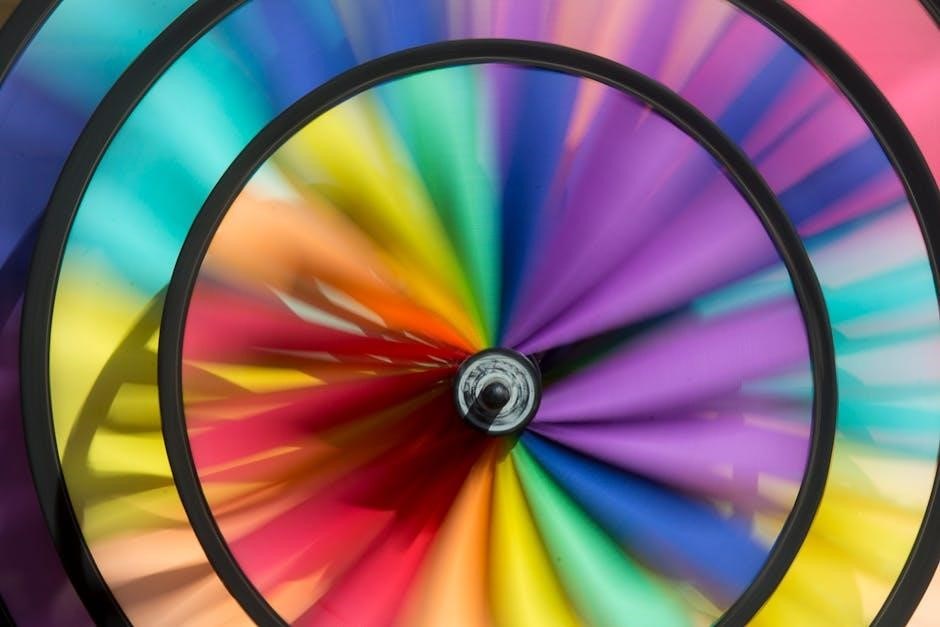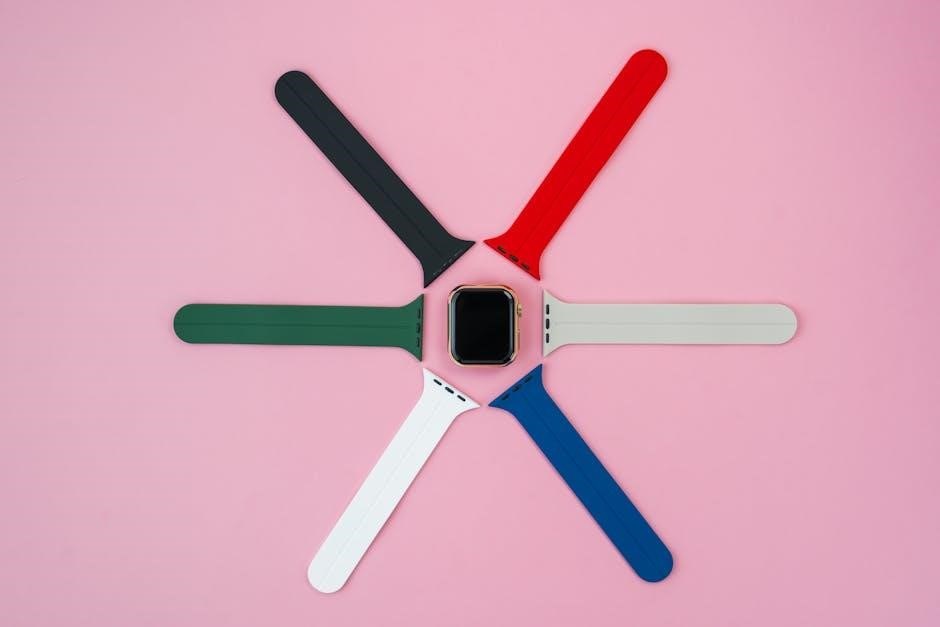The colour wheel is a circular representation of colours, showcasing primary, secondary, and tertiary hues. It helps understand colour relationships, harmony, and mixing principles. A colour wheel PDF is a practical tool for artists, designers, and educators, offering a visual guide to creating harmonious schemes and exploring colour theory. Its arrangement demonstrates how colours interact, making it essential for various applications, from art to branding. Digital tools like Adobe Illustrator can also generate custom colour wheels for specific projects.
1.1 Definition and Purpose
The colour wheel is a circular diagram that organizes colours systematically, showing their relationships and transitions. A colour wheel PDF serves as a practical, portable guide for understanding colour theory basics. It visually represents primary, secondary, and tertiary colours, demonstrating how they blend and contrast. The colour wheel’s purpose is to help artists, designers, and educators create harmonious colour schemes, explore mixing principles, and identify complementary tones. Its structured format makes it an essential tool for teaching and applying colour theory in various creative fields, from painting to digital design.
1.2 Historical Background
The colour wheel has its roots in Sir Isaac Newton’s groundbreaking work in 1666, when he refracted white light into its spectral components. Over centuries, it evolved through contributions from scientists and artists. In 1776, Jacob Christoph Le Blon developed the first three-color theory, while Johann Wolfgang von Goethe later explored colour perception. These advancements laid the foundation for modern colour theory. Today, the colour wheel remains a cornerstone in art and design education, with the colour wheel PDF serving as a versatile, accessible tool for teaching and application in various creative fields.

Structure of the Colour Wheel
The colour wheel is a circular diagram arranging colours systematically. It begins with primary colours, followed by secondary and tertiary hues. This structure facilitates understanding of colour relationships and harmony, making it an indispensable tool for artists and designers. A colour wheel PDF provides a convenient, portable format for exploring and applying these colour arrangements in various creative projects.
2.1 Primary, Secondary, and Tertiary Colours
Primary colours are red, blue, and yellow, which cannot be created by mixing others. Secondary colours, including orange, green, and violet, are formed by mixing two primaries. Tertiary colours emerge from combining primary and secondary hues, resulting in shades like blue-green and yellow-orange. This hierarchy is visually represented in a colour wheel PDF, helping users understand how colours relate and blend. Such a tool is invaluable for artists and designers seeking to create balanced and harmonious colour schemes in their work, whether digital or physical. This structured approach aids in predicting colour outcomes effectively.
2.2 Warm and Cool Colours
Warm colours, such as red, orange, and yellow, evoke warmth and energy, often associated with sunlight and heat. Cool colours, including blue, green, and purple, convey calmness and serenity, reminiscent of water and shade; The colour wheel PDF visually separates warm and cool hues, aiding designers in creating balanced compositions. Understanding this distinction is crucial for evoking specific moods in art and design. By strategically using warm and cool colours, creators can guide viewer emotions and enhance visual appeal in their work, whether digital or physical. This fundamental colour theory concept is essential for effective design practices.
2.3 The 12-Colour Wheel

The 12-colour wheel expands the traditional colour wheel by including tertiary colours, resulting in a more nuanced and detailed representation of colour relationships. It features primary colours (red, blue, yellow), secondary colours (orange, green, violet), and tertiary colours (yellow-green, blue-green, blue-violet, red-violet, red-orange, and yellow-orange). This extended format provides a broader spectrum for creating harmonious colour schemes and exploring subtle variations. The 12-colour wheel PDF is particularly useful for designers and artists seeking precise colour combinations. Its structure allows for enhanced creativity and understanding of colour gradations, making it a valuable tool for both beginners and professionals.
Colour Theory Basics
Colour theory explores the properties and interactions of colours, focusing on primary colours, colour mixing, and harmony. The colour wheel PDF simplifies understanding these principles visually, aiding in creating cohesive palettes for various applications.
3.1 Colour Harmony Principles
Colour harmony principles guide the creation of visually pleasing colour combinations. These principles include complementary, analogous, and triadic schemes, all of which can be easily identified using a colour wheel PDF. Complementary colours, found opposite each other on the wheel, create bold contrasts, while analogous colours, located side by side, offer cohesion. The colour wheel also aids in understanding warm and cool tones, enabling designers to evoke specific moods. By applying these principles, artists and designers can craft balanced and effective colour schemes. A printable colour wheel PDF is an invaluable tool for planning and teaching these fundamental concepts.
3.2 Colour Mixing and Pigments
Colour mixing and pigments form the foundation of colour theory, explaining how colours are created and combined. Primary colours—red, yellow, and blue—cannot be mixed from other hues and serve as the base for all others. Secondary colours, such as orange and green, are formed by mixing two primaries. The colour wheel PDF illustrates these relationships, showing how tertiary colours emerge from blending primary and secondary hues. Pigments behave differently than light, requiring an understanding of their properties. A colour wheel PDF is a practical resource for visualizing these mixtures and experimenting with colour ratios to achieve desired shades and tones.
3.3 The Role of Black and White
Black and white are not colours but play a crucial role in modifying hues. Adding black creates darker shades (tints), while white lightens them. These adjustments are essential for achieving desired moods in designs. A colour wheel PDF often includes black and white to demonstrate how they influence colour intensity and balance. By incorporating these neutrals, designers can enhance contrast and harmony in schemes. Understanding their impact is vital for creating visually appealing combinations, making the colour wheel PDF an invaluable tool for precise colour manipulation and emotional design outcomes.

Practical Applications of the Colour Wheel
The colour wheel is a versatile tool for artists, designers, and decorators, helping create harmonious colour schemes. It enhances visual appeal in branding, fashion, and interior design, ensuring cohesive and impactful results.
4.1 Art and Design
The colour wheel is an essential tool for artists and designers, providing a visual guide to colour relationships. It helps create harmonious compositions by identifying complementary, analogous, and triadic colour schemes. Print designers use it to ensure colour accuracy, while digital artists rely on it for consistent palettes. A colour wheel PDF is particularly useful for quick reference, offering a portable and shareable resource. Its applications range from mixing pigments to selecting digital hues, making it indispensable for both traditional and modern creative processes. This versatility ensures its continued relevance in the evolving art and design landscape.
4.2 Interior Design and Decorating
In interior design, a colour wheel PDF is invaluable for creating harmonious spaces. It helps designers select complementary and analogous colours, ensuring visual balance. By identifying warm and cool tones, it aids in evoking desired emotions—warm colours for coziness and cool tones for calmness. The portability of a PDF makes it easy to share with clients and contractors, facilitating collaboration. It also assists in coordinating wall colours with furniture and decor, ensuring a cohesive aesthetic. This tool is essential for crafting inviting and functional interiors that reflect both style and purpose.
4.3 Fashion and Textiles
In fashion and textiles, a colour wheel PDF is a powerful tool for designing cohesive collections. It helps creators identify complementary colours to craft visually appealing outfits and fabrics. By leveraging analogous and triadic colour schemes, designers can produce harmonious palettes that evoke specific moods or trends. The wheel also aids in selecting colours that flatter various skin tones, ensuring inclusivity. Additionally, it simplifies the process of mixing dyes and pigments for textiles, ensuring consistent hues across materials. This resource is indispensable for fashion designers aiming to create emotionally resonant and aesthetically pleasing garments and fabrics, both on and off the runway.
4.4 Branding and Marketing
A colour wheel PDF is invaluable in branding and marketing for creating visually impactful campaigns. It helps identify complementary and analogous colours to evoke specific emotions, aligning with brand identity. Marketers use the wheel to select harmonious palettes that resonate with target audiences, ensuring consistency across logos, packaging, and advertisements. Digital tools like colour wheel PDFs enable precise colour matching, ensuring brand cohesion. By leveraging colour psychology, businesses can convey messages effectively, enhancing brand recognition and customer trust. This resource is essential for crafting memorable and emotionally engaging brand experiences in competitive markets. It streamlines the design process, ensuring colours align with strategic goals.

How to Use a Colour Wheel PDF
A colour wheel PDF is a versatile tool for identifying complementary colours, creating harmonious schemes, and understanding colour relationships. Download, print, and use it to visualize colour mixing and harmony. It’s ideal for artists, designers, and educators, offering a practical guide to colour theory application. The PDF format ensures portability and ease of use, making it a valuable resource for both digital and physical creative projects.
5.1 Downloading and Printing
Downloading a colour wheel PDF is straightforward, with numerous free templates available online. Ensure the PDF is high-resolution for clarity. Print it on sturdy, glossy paper to retain vibrant colours. Adjust printer settings to match the colour profile for accuracy. Laminate the printed wheel for durability, especially for frequent use. This physical tool is versatile, serving as a quick reference for colour harmony, mixing, and scheme creation. It’s ideal for artists, designers, and educators seeking a practical, portable guide to colour theory principles.
5.2 Identifying Complementary Colours
Complementary colours are pairs of hues located directly opposite each other on the colour wheel. This placement creates visually striking contrasts, enhancing the intensity of each colour. To identify them, simply select a colour and find its direct counterpart across the wheel. For example, blue and orange are complements. This principle is widely used in art and design to add vibrancy and balance to compositions. It’s a key technique for creating dynamic colour schemes that capture attention and evoke emotions. Using a colour wheel PDF makes identifying these pairs quick and intuitive.
5.3 Creating Colour Schemes
A colour wheel PDF is an invaluable tool for crafting cohesive colour schemes. By analyzing the wheel, you can identify complementary, analogous, and triadic colour combinations. Complementary colours, located opposite each other, create vibrant contrasts. Analogous colours, found side by side, offer smooth transitions. Triadic colours, forming a triangle, provide balanced variety. These methods ensure harmony and visual appeal. Whether for graphic design, fashion, or interior spaces, a colour wheel PDF simplifies the process of selecting colours that work well together. It’s a practical resource for both professionals and novices aiming to enhance their creative projects with effective colour coordination.

Advanced Colour Wheel Techniques
Advanced techniques involve exploring complex colour relationships, such as gradient blends and nuanced harmony principles. A colour wheel PDF enhances these methods, providing precise tools for custom designs and projects.

6.1 Analogous and Split-Complementary Schemes
Analogous colour schemes use colours adjacent on the colour wheel, creating smooth transitions and harmony. Split-complementary schemes combine a base colour with the two colours on either side of its complement, adding vibrancy. These techniques are ideal for creating balanced designs. A colour wheel PDF helps visualize these relationships, making it easier to apply them in art, interior design, or branding. By exploring these schemes, designers can craft visually appealing compositions that evoke specific emotions and moods, enhancing the overall aesthetic of their work. These advanced methods are essential for achieving professional-grade colour coordination.
6.2 Triadic and Tetradic Colour Schemes
Triadic colour schemes use three colours evenly spaced on the colour wheel, forming a triangle. This creates vibrant, balanced compositions. Tetradic schemes involve four colours in a rectangular or square formation, offering rich variety. Both methods are versatile and can be adjusted for harmony. A colour wheel PDF simplifies the process of identifying these schemes, ensuring colours work well together. These techniques are widely used in graphic design, fashion, and branding to create visually striking and cohesive designs. By leveraging these schemes, creators can achieve dynamic and professional-looking results in their projects.
6.3 Colour Gradation and Tint/Shade Variations
Colour gradation involves transitioning smoothly between hues, creating a seamless visual flow. Tints are achieved by adding white to a base colour, while shades are made by adding black. These variations add depth and dimension to designs. A colour wheel PDF helps identify gradations and tints/shades, making it easier to plan and visualize. This technique is widely used in digital design, art, and fashion to create subtle effects or dramatic contrasts. By exploring gradations and variations, designers can craft sophisticated colour schemes that enhance visual appeal and evoke specific moods.

Colour Psychology and Emotions
Colour psychology explores how hues influence emotions and behaviour. Warm colours evoke energy, while cool tones promote calmness. A colour wheel PDF helps map emotional associations, enabling designers to craft impactful visual messages aligned with psychological principles. This connection between colour and emotion is vital for creating resonant designs in art, branding, and interiors. Understanding these dynamics enhances the ability to evoke desired feelings through strategic colour choices, making the colour wheel an indispensable tool for emotional design.
7.1 The Impact of Colour on Human Behaviour
Colour significantly influences human behaviour and emotions, often subconsciously. Warm colours like red and orange can stimulate energy and excitement, while cool colours like blue and green promote calmness. The colour wheel PDF serves as a valuable resource for understanding these psychological effects, helping designers and educators align colour choices with intended emotional responses. For instance, red can increase heart rates, while blue fosters trust. Cultural differences also play a role in colour perception, making it essential to consider diverse interpretations when applying colour theory. By leveraging the colour wheel, creators can strategically evoke desired emotional and behavioural reactions in their audiences;
7.2 Cultural Differences in Colour Perception
Cultural differences significantly influence how colours are perceived and interpreted. For example, while white symbolizes purity in Western cultures, it represents mourning in many Asian societies. The colour wheel PDF highlights these variations, offering insights into how different cultures associate colours with emotions, traditions, and values. Understanding these differences is crucial for global communication and design. By using a colour wheel, creators can tailor their colour choices to resonate effectively across diverse audiences, ensuring their message is conveyed without cultural misinterpretation and fostering inclusivity in their work. This awareness is vital for effective cross-cultural design and communication strategies.
7.3 Using the Colour Wheel for Emotional Design
The colour wheel is a powerful tool for creating emotionally resonant designs. By strategically selecting colours based on their psychological impact, designers can evoke specific emotions and moods. A colour wheel PDF helps identify complementary and analogous hues that align with desired emotional responses. For instance, warm colours like orange and red can stimulate energy and excitement, while cool tones like blue and green promote calmness and trust. Understanding these emotional associations allows designers to craft visually compelling and emotionally engaging experiences, ensuring their work connects deeply with the target audience on a subconscious level.

Digital Tools for Colour Wheel Creation
Digital tools like Adobe Illustrator, Canva, and online colour wheel generators simplify the creation of custom colour wheels. These tools offer features for selecting harmonious palettes, saving, and printing your designs effortlessly.
8.1 Software and Apps for Colour Wheel Design
Software like Adobe Illustrator and Procreate offer advanced tools for creating custom colour wheels. These apps provide features for precise colour picking, palette generation, and customization. Canva and Color Hunt are popular for their user-friendly interfaces and pre-designed templates. They allow users to export colour wheels as PDFs for easy printing. Many apps also support real-time colour adjustments and harmony suggestions. Professionals and hobbyists alike use these tools to streamline the design process and ensure accurate colour representations. They are indispensable for creating visually appealing and functional colour wheels tailored to specific projects.
8.2 Online Colour Wheel Generators
Online colour wheel generators are convenient tools for quickly creating custom colour wheels. Many websites offer free or subscription-based services, allowing users to select colours, adjust hues, and save results as PDFs. These tools often include features like colour pickers, RGB/HEX code input, and pre-designed templates. Popular options such as Canva, Color Hunt, and Adobe Color provide user-friendly interfaces for generating colour wheels tailored to specific projects. They are ideal for artists, designers, and educators who need to create and share colour wheels efficiently. These generators also support collaboration and real-time adjustments, making them versatile for both personal and professional use.
8.3 Customizing Your Colour Wheel PDF
Customizing your colour wheel PDF allows you to tailor it to specific needs, such as adding personal colours or adjusting the layout. Many online tools offer customization options, enabling users to import colours, edit existing wheels, and save changes. This feature is particularly useful for artists, designers, and educators who require unique colour schemes for projects or lessons. Customization ensures the colour wheel remains relevant and adaptable, making it a versatile resource for both digital and print applications. By personalizing your colour wheel, you can enhance its functionality and suitability for various creative and educational purposes.

Colour Wheel in Education
The colour wheel is a fundamental tool in education, helping students learn colour theory basics. Its visual representation simplifies understanding of primary, secondary, and tertiary colours. Educators use it to demonstrate colour mixing, harmony, and relationships, making complex concepts accessible. Interactive activities, such as creating colour wheels, engage students and enhance learning. A colour wheel PDF is a practical resource for classroom use, offering a hands-on approach to exploring colours and their properties. It fosters creativity and provides a foundation for art, design, and science studies.
9.1 Teaching Colour Theory to Students
Teaching colour theory to students is made engaging with a colour wheel PDF. This tool simplifies complex concepts like primary, secondary, and tertiary colours. Educators use it to demonstrate colour mixing, harmony, and relationships. Interactive activities, such as colour matching games or creating mood boards, enhance learning. The PDF format allows for easy sharing and accessibility, making it ideal for classroom or remote instruction. By using a colour wheel, students develop foundational skills in art, design, and even science, fostering creativity and critical thinking. It serves as a visual aid to explore how colours interact and influence each other.
9.2 Interactive Colour Wheel Activities
Engage students with interactive colour wheel activities using a PDF. Start with a Colour Scavenger Hunt, where students identify and match real-world objects to colours on the wheel. Another activity is Colour and Emotion Matching, inspired by Plutchik’s Emotion Wheel, to explore how colours evoke feelings. Collaborative Colour Art encourages teamwork to create harmonious posters. For digital learners, Colour Creations involves designing personal colour wheels using tools. Finally, Colour Matching Games test knowledge of complementary and analogous hues. These activities make learning colour theory fun and hands-on, fostering creativity and understanding.
9.3 Resources for Teachers and Learners
Enhance learning with diverse resources for colour wheel education. Colour Wheel PDFs are ideal for printing and hands-on activities. Utilize online generators to create custom wheels for specific lessons. Supplementary materials include colour theory workbooks and interactive digital tools like Canva or Adobe Illustrator for designing wheels. Educators can also incorporate educational videos and apps like Color Hunt for inspiration. Additionally, books on colour theory provide in-depth knowledge, while activity sheets and quizzes reinforce concepts. These resources cater to various learning styles, making colour theory accessible and engaging for all students.
Troubleshooting Colour Wheel Challenges
Addressing colour wheel challenges involves identifying colour blindness, fixing clashes, and adjusting palettes. A colour wheel PDF aids in resolving these issues, ensuring harmonious and accurate colour use.
10.1 Common Mistakes in Colour Selection
Common mistakes in colour selection include ignoring colour theory basics, using too many colours, and neglecting contrast. Overloading palettes and not considering colour context are also errors. A colour wheel PDF helps avoid these by providing a visual guide to harmonious combinations. Many designers forget to test colours under different lighting conditions, leading to mismatches. Additionally, insufficient planning and not aligning colours with the intended message can result in poor outcomes. Using a colour wheel PDF ensures a systematic approach, reducing errors and enhancing visual appeal in designs and artworks.
10.2 Fixing Colour Clashes
Colour clashes occur when hues lack harmony, creating visual discomfort. To fix this, use a colour wheel PDF to identify complementary or analogous colours that blend smoothly. Start by pinpointing the clashing colours on the wheel and finding their harmonious counterparts. Experiment with subtle variations in shade or tone to soften stark contrasts. Testing colours under different lighting conditions ensures accuracy. Tools like colour picker apps or software can also assist in refining palettes. By aligning colours with the wheel’s structure, you can achieve balance and resolve clashes effectively, ensuring a visually appealing result in designs or artworks.
10.3 Adjusting for Colour Blindness
Colour blindness, particularly red-green blindness, affects how individuals perceive hues. To accommodate this, use a colour wheel PDF with clear colour contrasts and avoid reliance on red-green differentiation. Choose high-contrast palettes and label colours explicitly. Digital tools can simulate colour blindness, helping designers anticipate and adjust. Testing with colourblind filters ensures accessibility. By simplifying colour schemes and enhancing legibility, designs become inclusive for all users, regardless of visual limitations. This approach fosters equality and ensures effective communication in art, design, and education.
Colour Wheel and Print Design
A colour wheel PDF is essential for print design, ensuring accurate colour representation. It helps select harmonious palettes and understand CMYK vs RGB modes for precise printing outcomes.
11.1 CMYK vs RGB Colour Modes
Understanding the difference between CMYK and RGB is crucial for print design. CMYK (Cyan, Magenta, Yellow, Key/Black) is used for physical printing, while RGB (Red, Green, Blue) is for digital screens. A colour wheel PDF can help designers visualize how colours will appear in both modes. CMYK produces deeper, richer tones, whereas RGB offers brighter, more vibrant hues. Ensuring colour accuracy requires testing designs in both modes. Using a colour wheel PDF tailored to CMYK ensures consistent results in print, avoiding colour mismatches. This step is vital for achieving professional-grade print materials;
11.2 Ensuring Colour Accuracy in Printing
To ensure colour accuracy in printing, it’s essential to use a colour wheel PDF that aligns with CMYK standards. This helps predict how colours will appear on paper. High-resolution images and precise colour profiles are critical for maintaining consistency. Always proofread your design before printing, as slight variations in colour can occur. Testing with a physical proof or sample print is recommended. A well-prepared colour wheel PDF ensures that the final output matches your digital design, avoiding costly reprints. This step is vital for professional results in branding, packaging, and art reproduction.
11.3 Preparing Your Colour Wheel PDF for Print
Preparing your colour wheel PDF for print involves ensuring high-resolution images and precise colour conversion to CMYK. Always include bleed and trim margins for accurate cutting. Embed fonts and graphics to prevent printing errors. Use vector graphics for scalable, crisp details. Save your file in PDF/X-1a format for compatibility with printing equipment. Include a colour chart for reference. Test with a physical proof to confirm colours and layout. This ensures your colour wheel prints professionally, maintaining its visual appeal and functionality for artistic or design purposes.
The colour wheel is an indispensable tool for understanding colour relationships, enhancing creativity, and making informed design decisions. Its practical applications span art, fashion, branding, and education, making it a cornerstone of colour theory. By exploring its principles and using resources like a colour wheel PDF, anyone can master colour harmony and unlock new possibilities in their work. Embrace this versatile tool to elevate your projects and continue discovering its endless potential.
12.1 Summary of Key Points
The colour wheel is a fundamental tool for understanding colour theory, offering insights into primary, secondary, and tertiary colours. It illustrates warm and cool tones, complementarity, and harmony principles. A colour wheel PDF serves as a practical guide for creating cohesive colour schemes, teaching colour relationships, and aiding in design decisions. Its applications span art, branding, fashion, and education, making it indispensable for creatives and educators alike. By mastering the colour wheel, users can enhance their projects and communicate effectively through colour, ensuring visual appeal and emotional resonance in their work.
12.2 Encouragement for Further Exploration
Exploring the colour wheel opens up endless possibilities for creativity and understanding. Whether you’re an artist, designer, or educator, delving deeper into colour theory can enhance your skills and inspire new ideas. Experiment with digital tools to create custom colour wheels and discover how colours interact. Use a colour wheel PDF as a handy reference for projects, from branding to interior design. Embrace the opportunity to learn about cultural perceptions of colour and how they influence design. With practice and curiosity, you can unlock the full potential of the colour wheel and elevate your creative work to new heights.
12.3 Final Thoughts on the Importance of the Colour Wheel
The colour wheel is a timeless and versatile tool that bridges creativity and technical understanding. Its universal applications in art, design, branding, and education make it an indispensable resource. By mastering the colour wheel, individuals can enhance their ability to communicate visually and emotionally. Whether using a traditional or digital colour wheel PDF, the principles remain consistent, offering a foundation for innovation. Its enduring relevance ensures that the colour wheel will continue to inspire and guide creators across disciplines, making it a cornerstone of visual expression and design.
